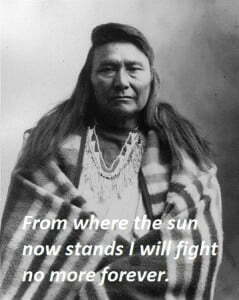Native Chiefs & Leaders: Chief Joseph
Chief Joseph was the leader of the Nez Perce tribe during a time of great conflict and upheaval. He was born in 1840 in Oregon Territory and assumed the role of Chief after the death of his father in 1871. “Nez Perce” was the name given to the tribe by a French Canadian interpreter with the 1805 Lewis and Clark Expedition. The tribe’s traditional name is Nimi’ipuu, which means “real people.” It serves them well as you look at their history.
Chief Joseph spoke of his tribe’s first encounter with white people, indicating that Lewis and Clark had been respectful and honest while passing through their lands.
The first white men of your people who came to our country were named Lewis and Clark. They brought many things which our people had never seen. They talked straight and our people gave them a great feast as proof that their hearts were friendly.
This was a far cry from the relationship Chief Joseph had experienced between the United States and the Nez Perce. His father made a treaty with the U.S. in 1855 reserving a large amount of land for the Nez Perce to live upon, but in 1863, the Gold Rush induced the U.S. to take back nearly 6 million acres and to allot a new, much smaller reservation for the tribe in Idaho. Chief Joseph’s father refused to move, remaining in the Wallowa Valley in Oregon territory as hundreds and hundreds of settlers continued to flood the Wallowa Valley. After Chief Joseph’s father died in 1871, the U.S. pressured all of the Nez Perce to move. The situation was incredibly volatile and violence seemed imminent.
Like his father, Chief Joseph had no desire to relocate to Idaho but did not want his people to suffer, starve, or be killed outright by the U.S. cavalry, which in 1877 threatened to move them forcefully to Idaho. So he agreed, but then some younger warriors attacked the settlers out of anger and 2,000 U.S. soldiers began to retaliate. Over 4 months and 1,400 miles, the Nez Perce forced what many at the time called the greatest military retreat in history. It ended just 40 miles from the Canadian border with the band surrounded and exhausted, but the bravery and fortitude of the Nez Perce elicited admiration even among staunchly unsympathetic counterparts.
There were just too many soldiers and Chief Joseph was tired of battles that chipped away at tribal members. He wanted peace for his people and safety for the women and children. He wanted them to live. So, on October 5, 1877, he formally surrendered, uttering this now famous quote:
Hear me, my chiefs! I am tired. My heart is sick and sad. From where the sun now stands I will fight no more forever.
Chief Joseph died in 1904, after being relocated several times by the U.S. and never returning to his homeland in the Wallowa Valley. His doctor said he died of a broken heart.
Chief Joseph was a man. He was also leader. And when you combine the two, you get a very human outcome. He wanted the best for his people, yet he wanted the U.S. to be respectful and honest, like Lewis and Clark had been, never taking more than they needed and giving equally in return. Perhaps he was an idealist, a human being that saw the potential for fairness, honesty, and equality. Ultimately, as history has recorded, Chief Joseph was a man of great integrity and foresight. He worked tirelessly to give his people what they had lost – the space and freedom to live as they had before the broken promises. And to this end, he came so close… 40 miles more and the history books may have been written quite differently.



One Comment
Thank you for the good writeup. Look forward to more added from you!